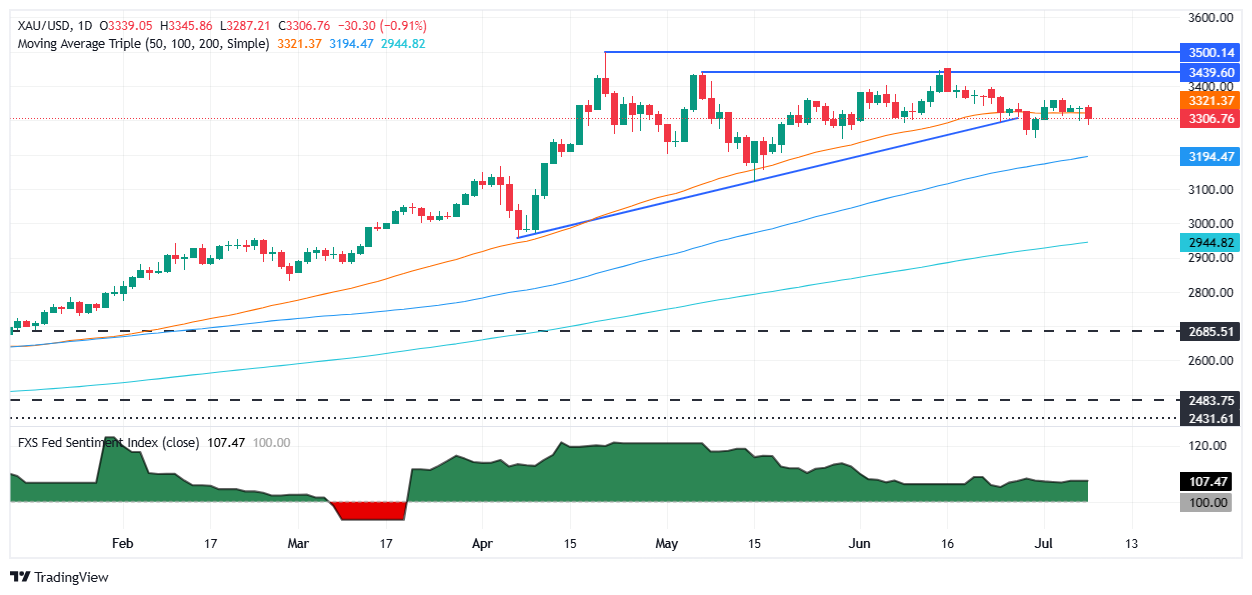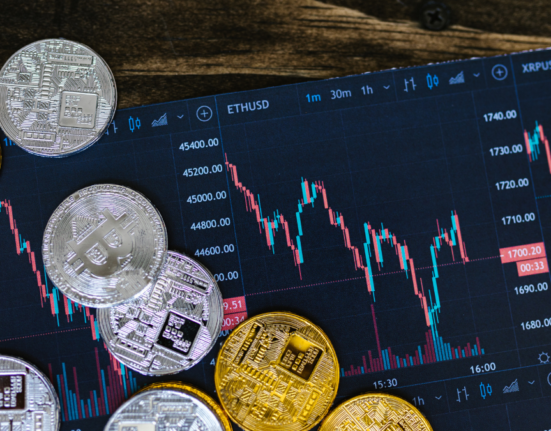- Gold drops over 1% as US Dollar and Treasury yields strengthen.
- Trump delays tariff deadline to August 1, calming trade nerves.
- Traders scale back 2025 Fed cut expectations to just 48 basis points.
Gold price is plunging over 1% on Tuesday during the North American session as appetite for its safe-haven demand diminished, although US President Donald Trump announced that the first tariff letters had been sent to some of the US’s trade partners. Additionally, the US Dollar’s recovery and heightened US Treasury yields exert downward pressure on the precious metal, which trades at $3,297 after reaching a high of $3,345.
Sentiment has improved, as depicted by the major US equity indices. On Monday, Trump imposed tariffs within the 25% to 40% range on 14 countries, although he decided to push back the July 9 deadline to August 1, stating that no further extensions would be warranted. Policymakers from Japan and South Korea said they would try to negotiate with the US, seeking a reduction of levies.
The jump in US Treasury yields also pressures the bullion price, as investors priced out rate cuts by the Federal Reserve (Fed). Data from the Chicago Board of Trade revealed that market players are eyeing 48 basis points (bps) of easing in 2025.
Traders are awaiting the release of the latest Federal Reserve meeting minutes on Wednesday. After that, the docket will feature the release of Initial Jobless Claims for the week ending July 5.
Daily digest market movers: Gold pressured despite witnessing the largest inflow to Gold ETFs
- Gold’s uptrend is questionable as it approaches strong support near $3,250. High US Treasury yields and a strong US Dollar are weighing on the yellow metal. The US 10-year Treasury note yield rose four basis points to 4.423%. US real yields are also up four bps at 2.073%. The US Dollar Index (DXY), which tracks the Greenback’s performance against a basket of currencies, advances 0.20% to 97.70.
- US President Donald Trump commented that the Federal Reserve Chair Jerome Powell should resign immediately and that the August 1 deadline is fixed. He stated that some tariff letters are at a rate of 60% or 70%. Regarding the European Union (EU), he said the EU is treating the US very nicely, that’s why he refrained from sending the letter.
- Trump added that he could have been harsher on trade and announced that he would impose duties on pharmaceuticals, semiconductors, and copper, which he said would result in tariffs of around 50%.
- The NFIB Small Business Optimism Index edged down to 98.6 in June, slightly below expectations of 98.7 and a decline from May’s reading of 98.8. The decrease was primarily driven by an increase in the number of respondents citing excessive inventories.
- Even though XAU/USD remains pressured, the World Gold Council (WGC) announced that Gold ETFs drew the largest inflow in five years during the first half of 2025. “Gold ETFs recorded an inflow of $38 billion in the first half of 2025 with their collective holdings rising by 397.1 metric tons of Gold.” The total holdings by the end of June rose to 3,615.9 tons, the largest since August 2022.
- The People’s Bank of China (PBoC) revealed that it added 70,000 tons, meaning that the central bank’s Gold reserves increased by 1.1 million since purchases resumed last November.
XAU/USD technical outlook: Gold price collapses towards $3,300
Gold’s uptrend remains in play, but it seems that buyers are losing steam. It is worth noting that the Relative Strength Index (RSI) triggered a ‘sell signal’ as the index crossed below 50, an indication that sellers are outweighing buyers.
From a price action perspective, XAU/USD needs to clear the June 30 low of $3,246 to pave the way for further downside, with the 100-day Simple Moving Average (SMA) at $3,181 eyed, followed by the May 15 low of $3,120.
Conversely, if XAU/USD climbs back above the 50-day SMA $3,320, expect a test of $3,350.

Gold FAQs
Gold has played a key role in human’s history as it has been widely used as a store of value and medium of exchange. Currently, apart from its shine and usage for jewelry, the precious metal is widely seen as a safe-haven asset, meaning that it is considered a good investment during turbulent times. Gold is also widely seen as a hedge against inflation and against depreciating currencies as it doesn’t rely on any specific issuer or government.
Central banks are the biggest Gold holders. In their aim to support their currencies in turbulent times, central banks tend to diversify their reserves and buy Gold to improve the perceived strength of the economy and the currency. High Gold reserves can be a source of trust for a country’s solvency. Central banks added 1,136 tonnes of Gold worth around $70 billion to their reserves in 2022, according to data from the World Gold Council. This is the highest yearly purchase since records began. Central banks from emerging economies such as China, India and Turkey are quickly increasing their Gold reserves.
Gold has an inverse correlation with the US Dollar and US Treasuries, which are both major reserve and safe-haven assets. When the Dollar depreciates, Gold tends to rise, enabling investors and central banks to diversify their assets in turbulent times. Gold is also inversely correlated with risk assets. A rally in the stock market tends to weaken Gold price, while sell-offs in riskier markets tend to favor the precious metal.
The price can move due to a wide range of factors. Geopolitical instability or fears of a deep recession can quickly make Gold price escalate due to its safe-haven status. As a yield-less asset, Gold tends to rise with lower interest rates, while higher cost of money usually weighs down on the yellow metal. Still, most moves depend on how the US Dollar (USD) behaves as the asset is priced in dollars (XAU/USD). A strong Dollar tends to keep the price of Gold controlled, whereas a weaker Dollar is likely to push Gold prices up.







